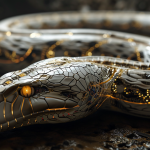
Pillow is a powerful Python Imaging Library that provides extensive capabilities for image processing and manipulation. It serves as a fork of the original PIL (Python Imaging Library) and has been actively maintained, making it perfect for developers looking to perform various artistic transformations on images.
With its simple API, Pillow allows for easy integration into projects, enabling users to apply filters, modify colors, and create visually appealing graphics. Below are some of the key features and capabilities that Pillow offers:
- Pillow provides tools to open, manipulate, and save images in various formats including JPEG, PNG, BMP, GIF, and TIFF.
- The library includes a range of built-in image filters that can be applied to enhance or alter the appearance of images. Some common filters include blur, sharpen, and edge enhancement.
- Users can manipulate shapes and colors with ease, allowing for adjustments in brightness, contrast, saturation, and hue.
- Pillow enables the creation of custom graphics through its drawing API, allowing developers to add text, lines, shapes, and other visual elements to images.
- The library supports not just standard image formats but also advanced features like transparency and animation in GIFs.
Pillow’s intuitive method calls allow users to perform complex image transformations with a minimal amount of code. Below is a simple example of how to open an image and apply a filter:
from PIL import Image, ImageFilter
# Open an image file
image = Image.open('example.jpg')
# Apply a Gaussian Blur filter
blurred_image = image.filter(ImageFilter.GaussianBlur(5))
# Save the modified image
blurred_image.save('blurred_example.jpg')
Overall, Pillow is a versatile and crucial tool for artists and developers alike, enabling them to create stunning visual content and push the boundaries of image transformations in their projects.
Installing Pillow for Image Manipulation
To get started with Pillow, the first step is to install the library. There are several ways to do this depending on your development environment. The most common method is to use pip, Python’s package installer. Below are the instructions for installing Pillow using pip and other methods.
- Using pip:
Pip is the easiest way to install Pillow. Simply open your command line or terminal and enter the following command:
pip install Pillowpip install Pillowpip install Pillow
This command will download and install the latest version of Pillow along with any of its dependencies.
- Using conda:
If you’re using Anaconda as your package manager, you can install Pillow using conda by running the following command:
conda install pillowconda install pillowconda install pillow
This will ensure that Pillow is installed in your Anaconda environment, and it will handle dependencies automatically.
- Verifying Installation:
After the installation, you can verify that Pillow has been installed correctly by running a simple Python script. Open your Python interpreter or create a new script and execute the following:
from PIL import Image# Check the version of Pillowprint(Image.__version__)from PIL import Image # Check the version of Pillow print(Image.__version__)from PIL import Image # Check the version of Pillow print(Image.__version__)
If the installation was successful, this will print the version number of Pillow you installed.
- Upgrading Pillow:
If you already have Pillow installed but want to make sure you have the latest version, you can upgrade it by running:
pip install --upgrade Pillowpip install --upgrade Pillowpip install --upgrade Pillow
This command will fetch the latest version and update your current installation.
By following these installation steps, you will be well on your way to using the powerful features of Pillow for your artistic image manipulations.
Essential Functions for Artistic Transformations
Pillow provides a variety of essential functions that facilitate artistic transformations of images. Understanding these functions enables users to apply effects, modifications, and artistic filters to their images with ease. Below, we explore some of the most important functions available in Pillow, along with practical code examples.
- Pillow includes several enhancement filters that can adjust the overall appearance of images. The
ImageEnhancemodule provides enhancements for brightness, contrast, color, and sharpness. Here’s how you can use these enhancements:
from PIL import Image, ImageEnhance
# Open an image file
image = Image.open('example.jpg')
# Enhance brightness
enhancer = ImageEnhance.Brightness(image)
bright_image = enhancer.enhance(1.5) # Increase brightness by 50%
bright_image.save('bright_example.jpg')
# Enhance contrast
enhancer = ImageEnhance.Contrast(image)
contrast_image = enhancer.enhance(2.0) # Double the contrast
contrast_image.save('contrast_example.jpg')
- Filters can be applied to images to create different artistic effects. The
ImageFiltermodule contains several built-in filters like blur, edge detection, and others:
from PIL import Image, ImageFilter
# Open an image file
image = Image.open('example.jpg')
# Apply an edge enhancement filter
edge_enhanced_image = image.filter(ImageFilter.EDGE_ENHANCE())
edge_enhanced_image.save('edge_enhanced_example.jpg')
- Pillow allows for direct color manipulation using the
convertmethod, which can transform images to different color modes, such as RGB, CMYK, or grayscale:
# Open an image file
image = Image.open('example.jpg')
# Convert image to grayscale
gray_image = image.convert('L')
gray_image.save('gray_example.jpg')
- Using the
ImageDrawmodule, you can add shapes and text to images. This allows artists to create custom graphics directly on their images:
from PIL import ImageDraw, ImageFont
# Create a blank image
canvas = Image.new('RGB', (400, 200), 'white')
draw = ImageDraw.Draw(canvas)
# Draw a rectangle
draw.rectangle([50, 50, 350, 150], fill='blue', outline='black')
# Add text
font = ImageFont.load_default()
draw.text((60, 90), 'Hello, Pillow!', fill='white', font=font)
canvas.save('drawn_example.jpg')
- Pillow provides functions for resizing and cropping images, essential for creating compositions and fitting images into specific dimensions:
# Open an image file
image = Image.open('example.jpg')
# Resize the image
resized_image = image.resize((200, 100)) # Resize to 200x100 pixels
resized_image.save('resized_example.jpg')
# Crop the image
cropped_image = image.crop((100, 50, 400, 300)) # Define the box to crop
cropped_image.save('cropped_example.jpg')
These essential functions enable users to perform a wide range of artistic transformations on images using Pillow. By using these functionalities, you can create unique and eye-catching visual compositions that stand out in any creative project.
Advanced Techniques for Custom Effects
# Import necessary modules
from PIL import Image, ImageFilter, ImageEnhance, ImageDraw, ImageFont
# Open an image file for transformation
image_path = 'example.jpg'
image = Image.open(image_path)
# Apply multiple filters for artistic effects
# Step 1: Apply a Gaussian Blur filter
blurred_image = image.filter(ImageFilter.GaussianBlur(5))
blurred_image.save('blurred_example.jpg')
# Step 2: Enhance the image's contrast
enhancer = ImageEnhance.Contrast(blurred_image)
contrast_image = enhancer.enhance(1.5) # 50% more contrast
contrast_image.save('contrast_blurred_example.jpg')
# Step 3: Draw a shape and text on the image
draw = ImageDraw.Draw(contrast_image)
draw.rectangle([50, 50, 350, 150], fill='blue', outline='black')
# Load default font
font = ImageFont.load_default()
draw.text((60, 90), 'Artistic Image!', fill='white', font=font)
# Save the final transformed image
contrast_image.save('final_artistic_example.jpg')
Pillow provides a variety of advanced techniques that can be used to create custom effects, allowing for even more creativity in artistic image manipulations. Below we explore several techniques that can transform images in unique ways:
- Developers can create their own filters by manipulating pixel data directly. This allows for a high degree of customization.
from PIL import ImageFilter, Image
class CustomFilter(ImageFilter.Filter):
name = "Custom Filter"
def __init__(self, matrix):
self.matrix = matrix
self.size = (3, 3) # A 3x3 filter
def filter(self, image):
return image.filter(self)
# Define a sample kernel for the filter
custom_matrix = [
-1, -1, -1,
-1, 9, -1,
-1, -1, -1,
]
# Apply the custom filter
image = Image.open('example.jpg')
custom_filtered_image = image.filter(CustomFilter(custom_matrix))
custom_filtered_image.save('custom_filtered_example.jpg')
Image.alpha_composite method.# Open two images to compose
background_image = Image.open('background.png').convert('RGBA')
foreground_image = Image.open('foreground.png').convert('RGBA')
# Composite the background with the foreground image
composed_image = Image.alpha_composite(background_image, foreground_image)
composed_image.save('composed_example.png')
# Open an image file
image = Image.open('example.jpg')
# Convert the image to RGB
image = image.convert("RGB")
# Access pixel data to manipulate colors
pixels = image.load()
# Loop over each pixel to modify color channels
for i in range(image.width):
for j in range(image.height):
r, g, b = pixels[i, j]
# Invert colors
pixels[i, j] = (255 - r, 255 - g, 255 - b)
image.save('color_inverted_example.jpg')
# Open an image file
image = Image.open('example.jpg')
# Apply rotation and translation
transformed_image = image.transform(image.size, Image.AFFINE, (1, 0, 50, 0, 1, 30)) # Move image by (50, 30)
transformed_image.save('transformed_example.jpg')
By employing these advanced techniques, artists and developers can experiment and develop unique custom effects using Pillow, opening new avenues for creativity in image manipulation. These tools allow for a greater level of artistic expression and can bring a distinctive flair to any project.
Practical Examples: Create Stunning Artworks with Pillow
Pillow offers a wide range of practical examples that demonstrate its capabilities for creating stunning artworks. Here are some hands-on projects using Pillow that can help you understand how to leverage its features effectively:
- You can create collages by combining multiple images into a single canvas. Below is an example of how to create a simple collage using Pillow:
from PIL import Image
# Create a blank canvas
collage_width = 800
collage_height = 600
collage = Image.new('RGB', (collage_width, collage_height), 'white')
# Open images
image1 = Image.open('image1.jpg')
image2 = Image.open('image2.jpg')
image3 = Image.open('image3.jpg')
# Resize images
image1 = image1.resize((200, 200))
image2 = image2.resize((200, 200))
image3 = image3.resize((200, 200))
# Paste images onto canvas
collage.paste(image1, (50, 50))
collage.paste(image2, (300, 50))
collage.paste(image3, (550, 50))
# Save the collage
collage.save('collage_example.jpg')
- You can create artistic effects by applying filters like contour or emboss. Here’s an example:
from PIL import Image, ImageFilter
# Open an image file
image = Image.open('example.jpg')
# Apply contour filter
contour_image = image.filter(ImageFilter.CONTOUR)
contour_image.save('contour_example.jpg')
# Apply emboss filter
emboss_image = image.filter(ImageFilter.EMBOSS)
emboss_image.save('emboss_example.jpg')
- You can simulate a watercolor effect using blurring and edge detection. Here’s how it can be done:
from PIL import Image, ImageFilter
# Open an image file
image = Image.open('example.jpg')
# Apply a Gaussian blur
blurred_image = image.filter(ImageFilter.GaussianBlur(5))
# Apply edge detection
watercolor_effect = blurred_image.filter(ImageFilter.FIND_EDGES)
watercolor_effect.save('watercolor_example.jpg')
- You can add textures to images for artistic effects. Below is an example of applying a texture to an image:
from PIL import Image
# Open base image and texture
base_image = Image.open('base_image.jpg')
texture = Image.open('texture.png')
# Resize texture to fit the base image
texture = texture.resize(base_image.size)
# Blend the base image with the texture
blended_image = Image.blend(base_image.convert('RGBA'), texture.convert('RGBA'), alpha=0.5)
blended_image.save('textured_example.png')
- Below is an example of how to create a cartoon effect by combining edge enhancement with color manipulation:
from PIL import Image, ImageFilter, ImageEnhance
# Open an image file
image = Image.open('example.jpg')
# Apply edge enhancement
edges = image.filter(ImageFilter.EDGE_ENHANCE())
# Enhance color
enhancer = ImageEnhance.Color(edges)
cartoon_image = enhancer.enhance(2.0) # Double the color saturation
cartoon_image.save('cartoon_example.jpg')
These examples demonstrate the versatility of Pillow in creating unique and artistic images. By combining various techniques and effects, you can unleash your creativity and produce visually appealing artwork. Each step demonstrates how simple commands can lead to impressive results when manipulating images with Pillow.






